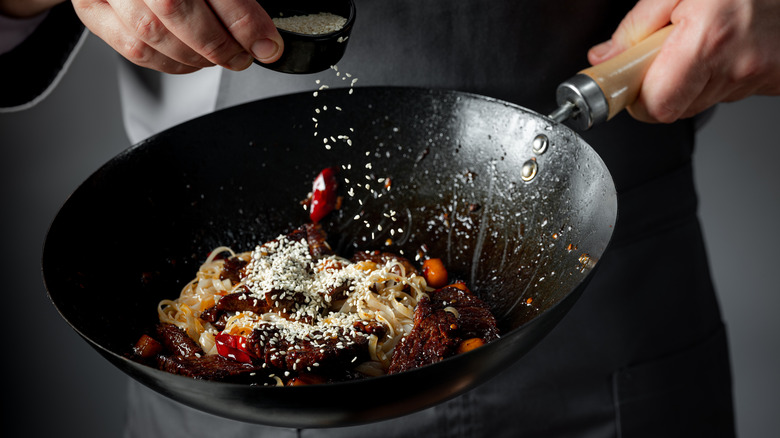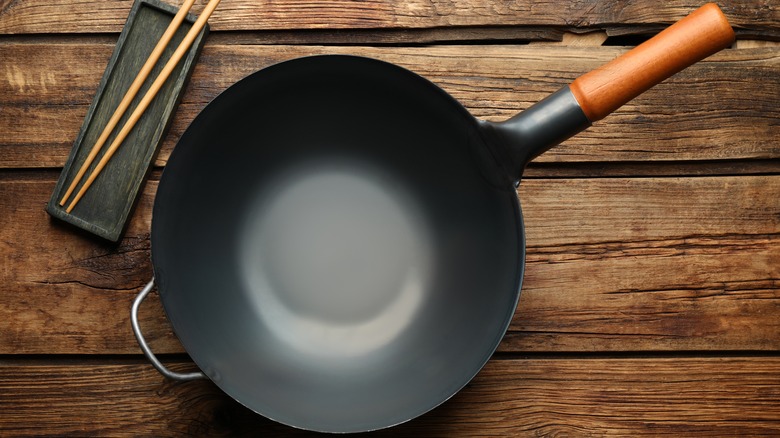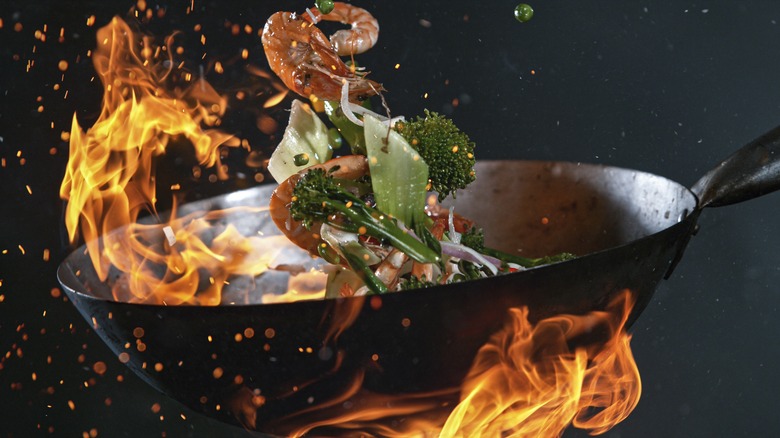The Only Type Of Wok You Should Use On An Induction Stove
A wok is a specialized pan designed to cook food quickly over high heat. Traditionally featuring sloped sides and a rounded base, legend has it that the wok's origin stems from Chinese soldiers using their helmets as makeshift pans while on marches. The wok is synonymous with many classic dishes in Asian cooking, including Yangzhou fried rice and stir-fried Sichuan chicken. In experienced hands, over a powerful open flame, woks can create a heat-scorched flavor in food known as "wok hei," which translates as "breath of the wok". Without a wok, it's hard to create wok hei, making the wok a desirable piece of kitchen gear for cooking some Asian recipes authentically.
With an induction stove, cooking with traditional round-bottomed woks is challenging. There's no open flame to lick the edges of the pan, coating your food in smoke and flame flavor. With its rounded base, when placed on a flat surface like an induction stove, a traditional wok will be unstable at best, and at worst, it'll fall immediately, tipping hot oil over your stovetop. Thirdly, induction stoves only generate heat in the base of a pan where it touches the stove.
The solution is a flat-bottomed wok. These have more base surface area for generating induction heat, are more stable, are a more recognizable shape for Western cooks at home, and still have classic sloped sides, which are important for wok-style cooking.
Choosing the best flat-bottomed wok for an induction stove
Depending on the angle of a wok's sides, the material it's made from, and its size, a wok will work better for certain dishes or preparations. However, since induction only works when a pan is in contact with the stovetop, there's little point in choosing a size and shape designed for the traditional tossing of ingredients in a circular motion. Plus, for home cooking, you probably want a flat-bottomed wok that's going to be versatile so it can be used for many different types of cooking.
Look for a flat-bottomed wok with a wide bottom. This reduces the chances of it tipping over when you're cooking, allows you to fit more food into your pan without overcrowding, and provides more contact area for your induction stove to generate heat. Of course, you can't cook anything on induction without a magnetic pan, so make sure you choose a wok made from iron, stainless steel, or carbon steel as these are all magnetic.
Before you go and invest in a flat-bottomed wok, there are some drawbacks to be aware of. Heat isn't distributed throughout the pan as effectively as with traditional rounded woks, which means a flat-bottomed wok may warp when exposed to high heat for a long time. But carbon steel is highly heat resistant and should help you steer clear of this issue. However, the heat concentration also increases the chance of food burning, so be vigilant!
How to create wok hei with an induction stove
Without a traditional concave bottom and with a powerful open flame, it may seem like there's no chance of getting a smoky wok hei flavor into your dishes. But that's far from true. In fact, you can get close to wok hei flavor without the ideal setup. Before you use your wok, cure it properly to prevent food from sticking and burning: A burnt taste is not the same as a smoky one! Next, before cooking, make sure the wok is super hot. Ideally, a temperature around 400 degrees Fahrenheit is suitable for wok cooking — you should hear loud sizzling as soon as your ingredients hit the pan.
Once the wok is hot, add a sensible amount of high smoke-point oil before adding your ingredients. When adding soy sauce, it's often better to add this to the sloped sides of the pan rather than directly on the ingredients. This allows the soy sauce to reduce and partly evaporate as it runs down to the base of the wok, so you get a more concentrated, smoky-soy flavor but less saltiness. Also, a little sesame oil can go a long way to emulate the smoke-like flavor of wok hei. If all else fails, you could blowtorch ingredients as they're cooking in the wok; this will certainly achieve a wok hei flavor, but you'll need to manage a wok in one hand and blowtorch in the other — no easy feat!


